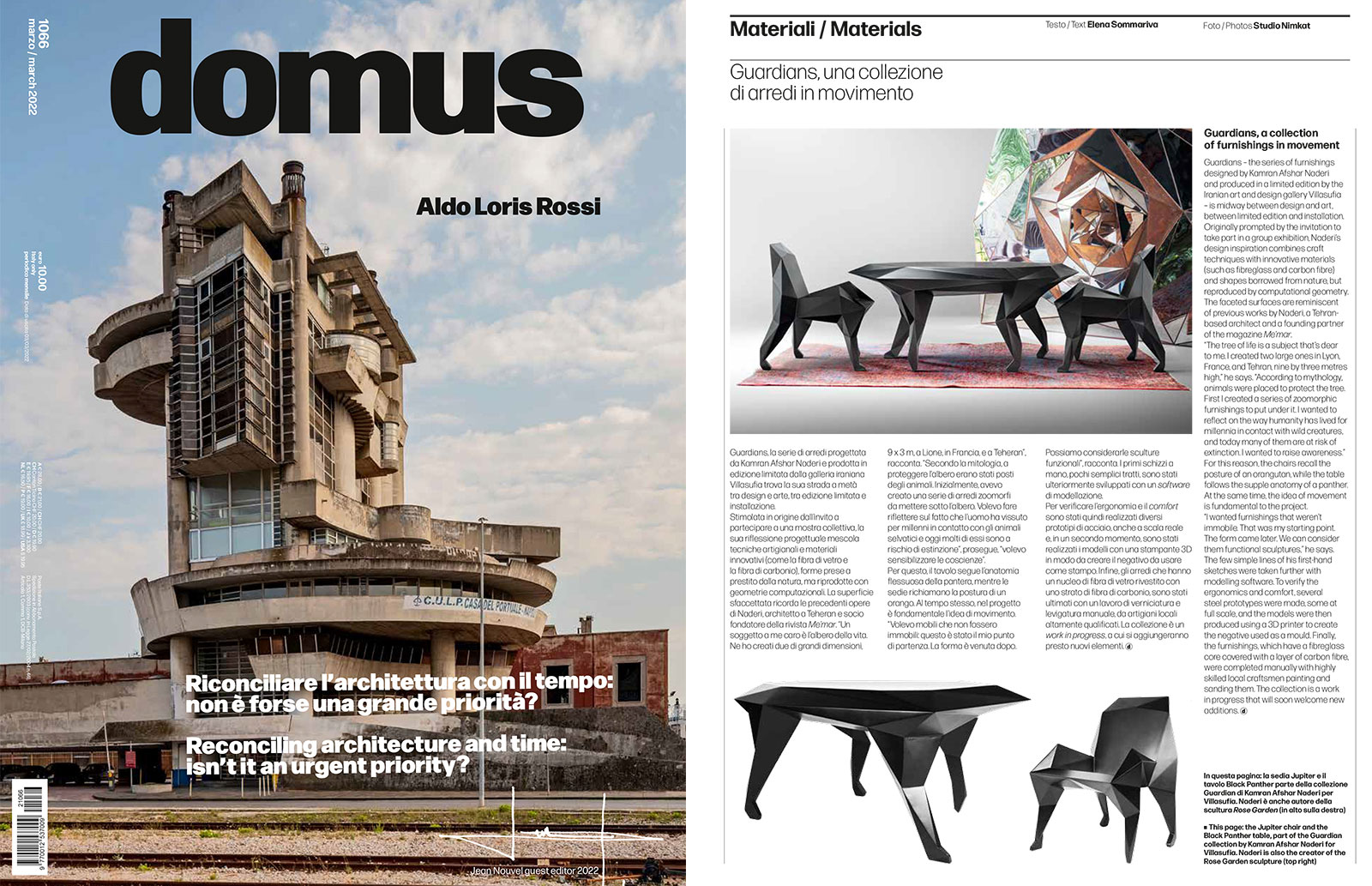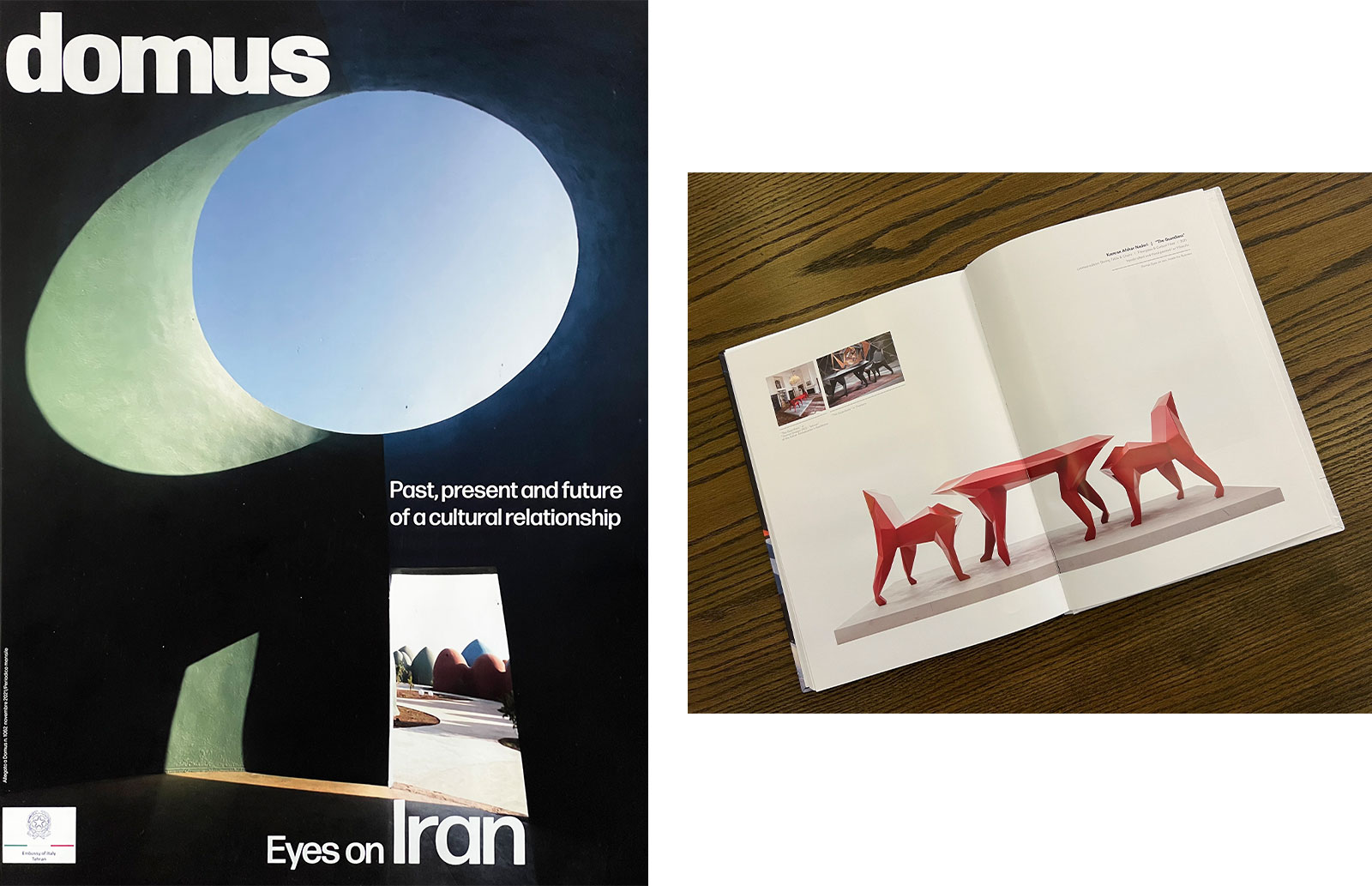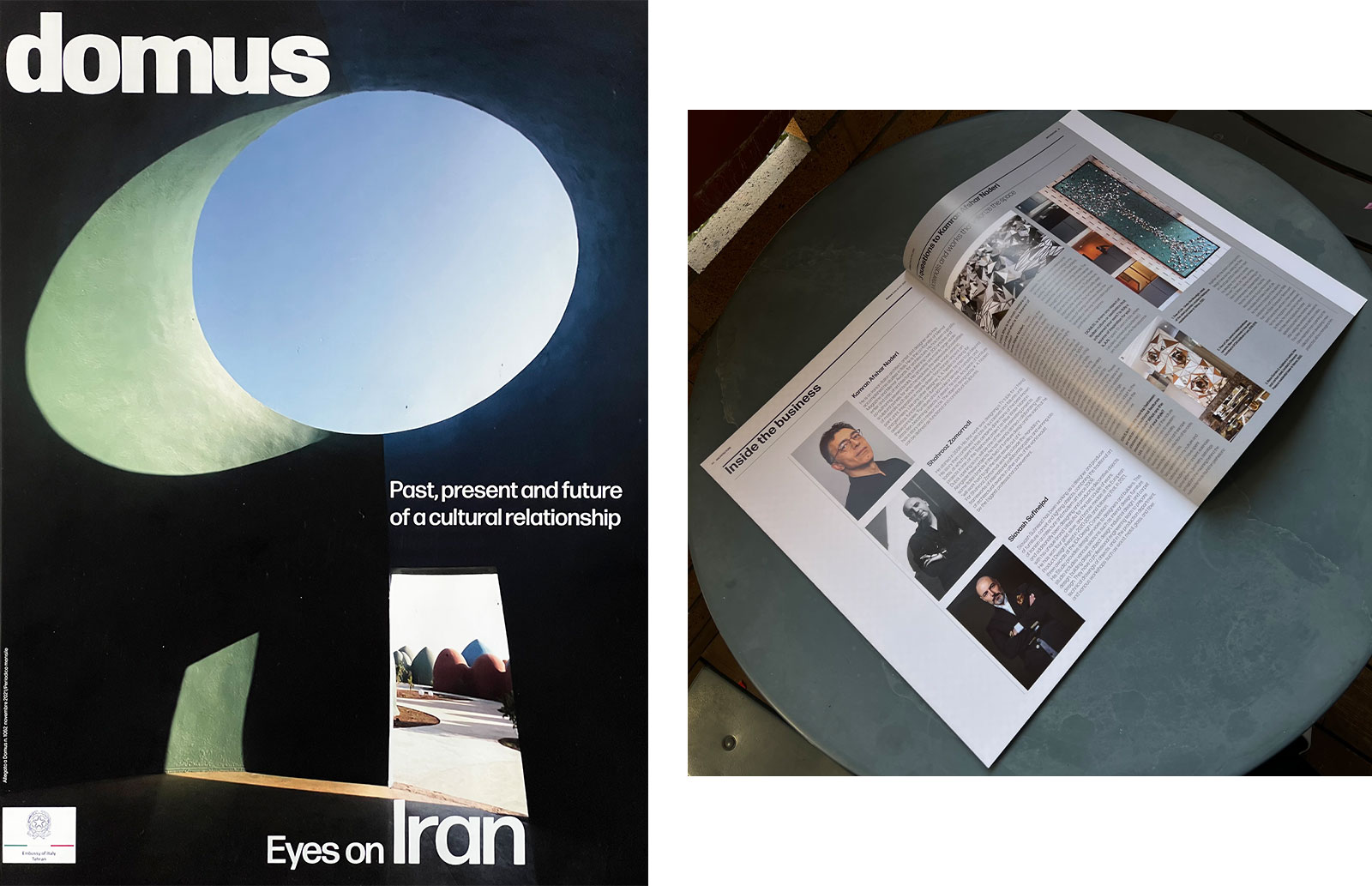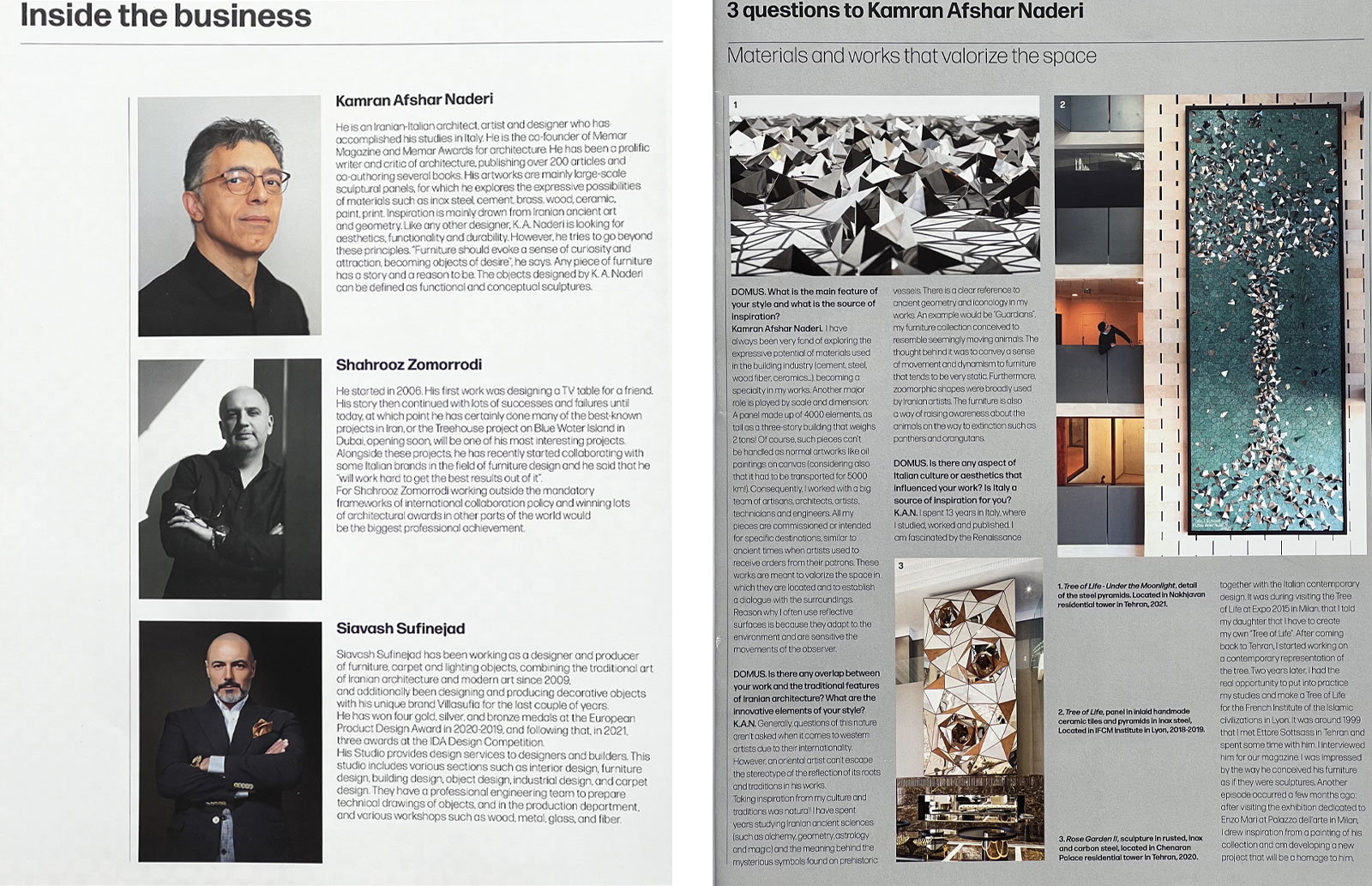KAN Artworks
Kamran Afshar Naderi is an Iranian-Italian artist, designer and architect who has attended his studies at Conquer Institute of arts (Tehran), Faculty of Fine Arts (at Tehran University) and Faculty of Architecture of Genoa (Italy). He is the co-founder of Memar Magazine and Memar Awards for architecture. He has been a prolific writer and critic of architecture, publishing over 200 articles and co-authored several books. He is a frequent guest lecturer at universities and conferences in several Asian and European Countries.
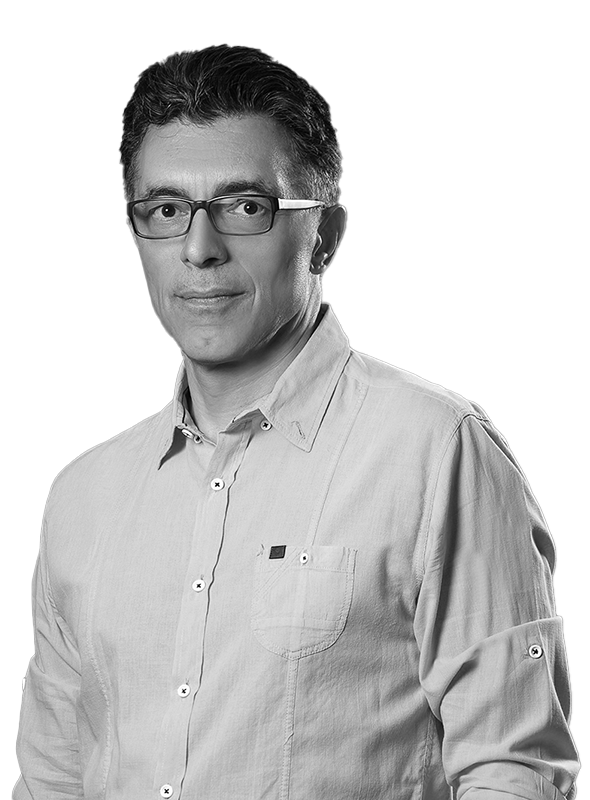
Mission
Art
Furniture
Media & Awards
Selected Artworks & Furnitures
Tree of life – IFCM institute, Lion 2018-2019
Introduction:
The Tree of Life is the name of a project started in 2015 as an experimentalstudio work. The tangible result of this endeavor came in 2018 when IFCM (French Institute of the Islamic Civilizations) asked for an artwork (9.50 x 3.50 m) to be installed at the main hall. The Tree of life is a widespread myth or archetype in the world's mythologies, related to the concept of sacred tree. The concept of the sacred tree can be found in all the ancient cultures and beliefs. Tree of life could match properly with the given dimensions of the artwork and convey the spiritual message of this multicultural location.
This sculptural panel is made of 3000 inlaid hand painted ceramic tiles and 360 complex pyramidal elements in inox steel and ceramics. The complex geometry of the panel is based on an ancient Persian geometrical pattern called soremedan-e-kond.
The artwork has been unveiled in presence of Mr. Christophe Castaner, Minister of the Interior and Mr. Gérard Collomb, the Mayor of Lyon. The artwork has been created in collaboration with a large team of artists, craftsmen, architects, engineers and technicians. The thousand pieces of turquoise hand designed inlaid ceramics with calligraphic motifs have been carried out by Leila Farzaneh Art Studio.
Tree of life – under the moon light 2021
The new Tree of Life started in 2021 as a project for exploring the new expressive potentials of the ancient myth of the sacred tree. This sculptural panel is located in the lobby of a luxurious residential building in Niavaran neighborhood in northern Tehran. The dimensions of the new artwork (9.00 x 3.00 m) are similar to the previous tree of life; however, the new tree has different, colour, form and material. Differently from the one installed at IFSM (Lion-France), here, a new and more dynamic geometric pattern has been used as a base. The grid was designed using a water-based paint on a microcement bed. The chiaroscuro texture has been craftily designed by hand using the sponge technique. Tree itself follows a dynamic form, made of hundreds of irregular pyramids in reflective black inox steel. The black and shades of gray used in this artwork, evoke the nocturn atmosphere.
Rose Garden – 1 - 2019
Rose Garden 1, is a sculptural panel of variable thickness (measuring 3.50 x 3.50 m) built entirely in steel. It is a puzzle of 510 pieces of rusted steel, carbon steel and inox steel. Rose Garden reveals the hidden geometry of Rose (an iconic motive in Persian as well as in western cultures) in the form of a reflective and multifaceted sculpture. The work, exhibited at Niavaran Cultural Center and Villasufia (in Tehran) has been reviewed by the local media. It is currently installed at Villasufia art and furniture gallery, in Tehran.
See MoreRose Garden – 2 - 2020
Rose Garden 2, is a new version of Rose Garden 1 (measuring 5.80 x 2.80 m) and consists of 570 pieces of steel. Rose Garden reveals the hidden geometry of Rose (an iconic motive in Persian as well as in western cultures) in the form of a reflective and multifaceted sculpture. The artwork is permanently installed at the penthouse of Chenaran Palace (a luxurious residential tower in northern Elahiyeh neighborhood in Tehran).
See MoreZuleikha Palace (homage to Enzo Mari)
The seduction of Joseph by Potiphar’s wife is an important narrative in the Old Testament and is also part of the Quran.
Many visual interpretations of this narrative are present in both Judeo-Christian art as well in Islamic miniatures. Bihzad is a famous Persian painter of the 16th century. In his interpretation of “Joseph and Zuleikha” the architectural environment is represented using parallel lines and not perspective lines that seem to converge to a point in the space. The miniature painting shows the seven doors of the palace (locked by Zuleikha to stop Joseph from escaping as described in the narrative) and the labyrinth-like positioning of the doors. In Persian literature the opening of these doors is seen as the seven levels of purification that Joseph goes through. The whole scene unfolds on a flat piece of paper.
Zuleikha Palace is an artwork (3.00 x 2.00 m), made in inox steel. This piece's atmosphere was given by a combination of the traditional miniature flat perspective, the scientific perspective and the tridimensional perspective (sculptural form of the artwork). The multipoint perspective, corridors that go in several directions and the sequence of frames, represent the difficult route of Joseph for escaping from Zuleikha.
The general organization of the form is inspired by a few paintings of Enzo Mari, the Italian Designer (1932-2020) who passed away a few months before starting this project.
This sculpture drew inspiration from the work of two great artists: Kamaladin Behzad, Persian painter and curator of the royal ateliers in Herat and Tabriz during the late Timurid and early Safavid periods; and Enzo Mari, Italian modernist artist and furniture designer and his studies on multi-point perspective.
In the Iranian literature, the story of Yusuf and Zuleikha has always been a topic of interest for writers and poets, and was retold in various narratives. One of these narratives was by the 13th century poet Sa'adi. Two centuries later Sultan Ali al-Katib put it in writing, with illustrations by the Persian artist Kamaladin Behzad. In this story Zuleikha (Potiphar's wife) chases Yusuf through the seven rooms of her palace. In the last room she tries to embrace him, but he manages to escape untouched. In this artwork, the multiple frames that seem to escape from the observer and extend in the left, right, up and down convey a sense of entrapment and disorientation. The combination of flat perspective and the tridimensional faceted mirror surfaces, increase the visual ambiguity of the sculpture. It seems that the observer is invited to enter in to the artwork space.
The Guardians collection – 2020-2021
“The Guardians”, is the name of a new collection of furniture, including a set of tables (Black Panther) and chairs (Jupiter), produced by Villasufia. The prototypes were made of steel sheets. Once the shape of the objects completed, the molds were accurately crafted using the 3D printing machinery. The furniture was entirely produced in fiberglass and carbon fiber. The final finishing included several hands of sanding, puttying and painting.
The zoomorphic form of the collection “Guardians” is based on various animal anatomy studies. Since ancient times, the zoomorphic shapes were broadly used by Iranian artists. The capitals used in the Persepolis complex are a representation of griffin or bulls. The legs of Achaemenid thrones were conceived in the form of a lion's leg.
The Industrial revolution and the contemporary era, caused a gap between human existence and nature. Animals and the wild world played an important role in the formation of astrology, mythology and culture. Furthermore, the anatomy of wild animals conveys a sense of movement and dynamism, which contributes to giving a household a more jolly and fresh environment considering the fact that furniture tends to be extremely static.
Tree of life – under the moonlight
The tree of life is a widespread myth or archetype in the world's mythologies, related to the concept of sacred tree. The concept of the sacred tree can be found in all the ancient cultures and beliefs like Ancient Iran, Mesopotamia, Urartu, Buddhism, Ancient China, Christianity, Islam, Germanic paganism and Norse mythology, Jewish religion, European ancient cultures, Mesoamerica and North America, Turkish culture, Hinduism and many others. This artwork follows the previous artwork almost of the same size (9.00 m H, 3.00 m W) installed at the IFCM institute in Lyon. It represents the nocturne version of the tree of life, realized with various material including wood, microcement, inox steel and paint. The artwork is installed at the main lobby of a luxurious residential tower in Northern Tehran.
See MoreVulcan
Brass on pre-existing marble slabs (measuring 4.60 x 7.20 m).
I drew inspiration from the geometry of the veins of a pre-existing stone wall above the fireplace. Looking at the artwork, it looks like a vaguely defined mysterious creature that jumps over the fireplace. The work is inspired by the myth of Vulcan, the god of fire and metalworking in ancient Rome. The concept is related to the function of the wall as the fireplace and the brass forms created by our artisans. The work represents the difficult attempt to adapt an artwork to a formally well-defined pre-existing situation. Vulcan is installed in the hall of a penthouse located in one of the residential towers in northern Tehran.
Design collaborator: Rashed Fatehi
Installation coordinator: Kamran Tafreshi
Brass work: Noorik Zohrabi Masihi
Team director: Alp Mohazzab
Other collaborators:
Y. Nazeri, F. Roshan
The zoomorphic form of the collection “Guardians” is based on various animal anatomy studies. Since ancient times, the zoomorphic shapes were broadly used by Iranian artists. The capitals used in the Persepolis complex are a representation of griffin or bulls. The legs of Achaemenid thrones were conceived in the form of a lion's leg.
The Industrial revolution and the contemporary era, caused a gap between human existence and nature. Animals and the wild world played an important role in the formation of astrology, mythology and culture. Furthermore, the anatomy of wild animals conveys a sense of movement and dynamism, which contributes to giving a household a more jolly and fresh environment considering the fact that furniture tends to be extremely static.

